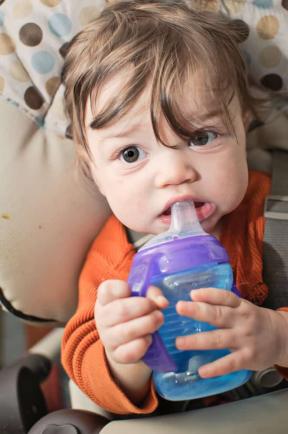
Whether it's organic, local, 100 percent fruit or fresh pressed, the cup of juice clutched in your toddler's hands might as well be soda. When it comes to sugar levels - in the form of fructose - there isn't much difference between the two.
Surprised?
In a nutritional study, researchers charted the amount of fructose found in popular brands of sodas and juices - with shocking results. Tests showed a liter of Minute Maid 100 percent Apple Juice has a whopping 66 grams of fructose. On the other hand, Coca-Cola contains 62.5 grams per liter. That's right, this particular brand of 100 percent apple juice has more fructose than soda.
But isn't there a difference in the fructose sugars? Fruit juices are natural while sodas use artificial and processed sweeteners. Doesn't that make fruit juices healthier?
Not quite.
Whether the fructose is from a factory or Mother Nature herself, the body processes it the same way. Unlike glucose, which is used for energy in the body, the fructose found in both juices and sodas is sent straight to the liver. Here, it isn't used for energy, instead is stored as fat.
The danger with fruit juices is that the juice takes all of the fructose without any of the fiber. When you are eating fruit whole, you are also consuming fiber along with the fructose. Fiber slows down the body's absorption of fructose, reducing the amount that is absorbed in the body. When you are drinking fruit juice, you aren't getting that benefit.
Michael Goran is one researcher investigating how fruit juices create health risks like obesity and diabetes. The ill effects of high fructose corn syrup found in processed foods and drinks have been heavily researched, but fruit juices have been largely ignored. Goran stresses that the high sugar content found in fruit juices can be just as dangerous to your health as processed sugars found in other foods and drinks.
So should you just replace your morning glass of juice with soda pop? Perhaps, not. Fruit juices are still providing high amounts of vitamins that aren't found in your favorite fizzy drink. Sodas also contain chemicals and colorings that aren't found in 100 percent fruit juices. Fruit juices may be loaded with sugar, but that doesn't mean you shouldn't replace them with sodas. If you continue drinking fruit juices, try these four ways to cut down on the sugar:
1. Don't forget your veggies
Drinking pulpy vegetable juices have less sugar than fruit juices. The pulp also adds more fiber, keeping you full longer and preventing your body from absorbing as much fructose. Many vegetables also have high levels of vitamins found in fruit juices, making it a win-win.
2. Drink juice like Grandma did
Your grandparents sipped their juice from petite little glasses that didn't hold much more than a few ounces. These days, juice glasses are much larger, allowing you to pour in more servings and more sugars into each glass. Even a recommended 8 ounce serving of juice can pack in quite a bit of sugar. Try dusting off those antique juice classes to manage a small portion, instead.
3. Do your research
Some companies have caught onto the research about sugar levels and are working to reduce the amount in their products. Comparing brands can help you cut down on sugar intake without having to stop drinking juice altogether.
4. Just add water
If a single sippy cup of juice isn't going to cut it for your little tyke, try diluting their juice with half water or seltzer for a little fizz. You will be able to stretch out one serving into two without doubling the sugar.
Culturally, foods and drinks are really sweet and pack in a lot of sugar in each serving. Helping to reduce your daily amount of sugar and how many sweet drinks you have can help avoid some serious health risks.

